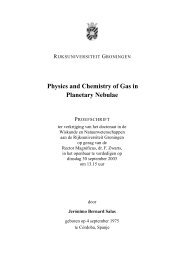TRACING ABUNDANCES IN GALAXIES WITH THE SPITZER ...
TRACING ABUNDANCES IN GALAXIES WITH THE SPITZER ...
TRACING ABUNDANCES IN GALAXIES WITH THE SPITZER ...
You also want an ePaper? Increase the reach of your titles
YUMPU automatically turns print PDFs into web optimized ePapers that Google loves.
lines. For example, changing the adopted Te from 10000 K to 13000 K for the PN<br />
IC 2448 decreases the abundance of Ne ++ derived from the IR [Ne III] line at 15.55<br />
µm by 6% but decreases the abundance of Ne ++ derived from the optical [Ne III]<br />
line at 3869 ˚A by 80%. (3) Some ions have lines in the infrared, but not in the<br />
optical; for example, infrared spectra show the [Ne II] line which is not observable<br />
in the optical, but this ion dominates the total elemental neon abundance in low<br />
ionization nebulae.<br />
1.3.4 Ionizing Radiation Field<br />
Massive stars and active galactic nuclei produce a hard radiation field (a radiation<br />
field which contains a large fraction of highly energetic photons) of high intensity.<br />
The hardness of a radiation field gives information about the type of source creating<br />
the field. Ratios of IR lines arising from ions which have ionization energies in the<br />
ultraviolet indicate the radiation field hardness. For example, it takes 22 eV to<br />
create Ne + from neutral neon and 41 eV to create Ne ++ from Ne + , so if the line flux<br />
ratio F(Ne III at 15.6µm)/F(Ne II at 12.8 µm) is high, then the ionizing radiation<br />
field is hard. Similarly it takes 23 eV to create S ++ from S + and 35 eV to create<br />
S +3 from S ++ , so the line flux ratio F(S IV at 10.5 µm)/F(S III at 18.7 µm) also<br />
probes the ionizing radiation field. Figure 1.4 shows the ionization energies for<br />
these ions overplotted on synthetic spectra for a burst of star formation generated<br />
with the code Starburst99 2 .<br />
Several factors affect the hardness of the radiation field. Figure 1.4 shows four<br />
synthetic spectra: one for each of two abundances (1 and 1/3 solar) and one for<br />
each of two times (1 and 10 Myr) after the burst of star formation began. The<br />
radiation field is harder, having higher energy photons (to the left in the figure)<br />
2 Starburst99 (Leitherer et al., 1999) is available from the following website:<br />
http://www.stsci.edu/science/starburst99/ .<br />
20













